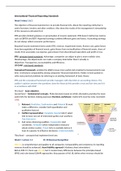Summary
Summary IFRS (lectures, tutorials and book)
- Course
- Institution
- Book
A complete summary of IFRS from the Master Accountancy & Control at the UvA. This summary contains all the required exam material from the lectures, tutorials and book. I also added some details from last year's course Financial Accounting 3, which are used again (and revelant) in this course.
[Show more]




